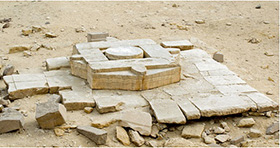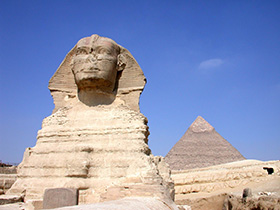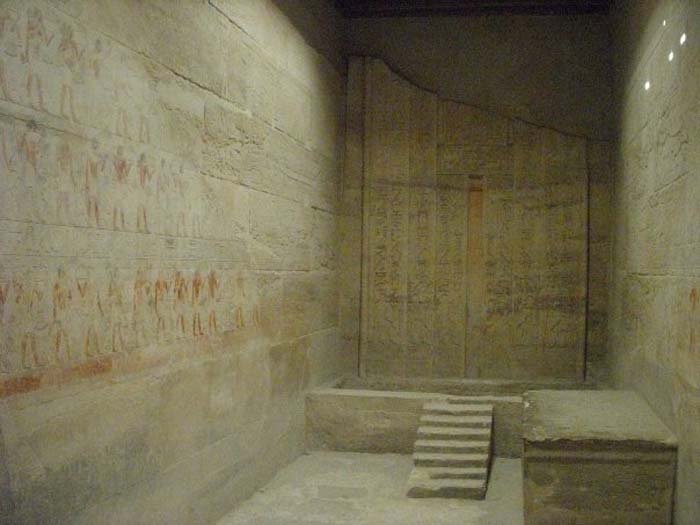

The first true pyramid was built in 2630 B.C. Pyramids were "designed to awe the ancient Egyptians, to impress them with their ruler's godlike strength,” one scholar said. The Old Kingdom pharaohs built pyramids for only a couple of centuries. Tombs were built at Giza until about 2152 B.C. The last pyramids were built around 1700 B.C. After that rulers were buried in cliff side or underground tombs like those found in the Valley of the Kings in Luxor. The pyramids were plagued by grave robbers. The tombs in the Valley of the Kings could be more easily guarded.
According to Minnesota State University, Mankato: “The earliest known pyramid structure is that of the Pyramid of Meidum. There are two theories as to the pyramids construction. One states that the pyramid was started by Huni, Snefer's predecessor, the other that it was began and ended with Sneferu. Whatever the case, the reign of Sneferu went on to produce two more pyramids after Meidum. Meidum, however, was not always in it's rough state as is seen in the picture at left. As is evidenced by graffiti on the outside of the pyramid, the pyramid survived well into the time of the 18th Dynasty. Meidum still stands as a great attempt, if not a triumph of Egyptian architecture. Other pyramids constructed during the time of the Fourth Dynasty include, the Pyramid of Djeddefre, (created by the son of the Pharaoh Khufu), The Pyramids of Giza, The Sphinx, and many many other tombs, temples and pyramids. [Source: Minnesota State University, Mankato, ethanholman.com +]
The reigns from Huni, the last king of the Third Dynasty of the Old Kingdom to Djedefre --- Radjedef the son of Khufu, the builder of the Great Pyramid ---in the middle of the Fourth Dynasty of the Old Kingdom is regarded by some scholars as the true Age of the Pyramids, a period of great technological and ideological innovation.Richard Bussmman of University College London wrote: "Different from the later Old Kingdom, the pyramids and court cemeteries of this period are located within a radius of seventy kilometers from Maidum in the south up to Dahshur, Giza, and Abu Rawash in the north. This wide geographical spread is typical of the early and mid-4th Dynasty. In the late 4th, 5th, and 6th Dynasties, the court cemeteries cluster around Saqqara and Abusir, closer to where an urban center formed, later called Memphis. The Manethonian copies insert a break before Sneferu, whereas the earlier annalistic tradition does not single out the early 4th Dynasty as a separate period. [Source: Richard Bussmman, University College London, UCLA Encyclopedia of Egyptology, 2015, escholarship.org ]

Bent Byramid of Dashoor
“The reigns from Huni to Radjedef date approximately to the mid-third millennium B.C.. However, the annalistic tradition offers conflicting information on the names of kings and the length of their reigns, especially for the 3rd Dynasty. If “year of counting” and “year after counting” refer to a strictly biannual rhythm, the entries in the Turin Royal Canon would contradict the contemporaneous 4th Dynasty evidence derived predominantly from graffiti on pyramid blocks . Absolute dates for the reigns of Huni to Radjedef vary between a “high chronology,” 2637 to 2558 B.C., and a “low chronology,” c. 2550 to 2475 B.C. Radiocarbon dates are in better agreement with the high chronology. Estimations of the length of the early to mid- 4th Dynasty significantly exceeding 100 years have not been proposed so far.
"Geographically, the archaeological and inscriptional evidence of the early 4th Dynasty concentrates on the Memphite cemeteries. The location of Huni’s tomb is unknown. Sneferu built the pyramid at Maidum and the Bent Pyramid and Red Pyramid at Dahshur. The tombs of the 4th Dynasty courtiers and later officials at both sites have recently been reinvestigated. Khufu moved the court cemetery to Giza and buried huge boats next to his pyramid. The burial (?) equipment of Hetepheres, perhaps Khufu’s mother, was found secondarily deposited in a cache and yielded spectacular finds, such as wooden poles of a royal canopy, a bed, and a carrying chair. The pyramid and court cemetery of Radjedef is located at Abu Rawash. When Khafra returned to Giza, he embedded his pyramid and the sphinx in the infrastructure established by Khufu."

The Pyramids of Giza are an important part of ancient Egypt, as well as present-day Egypt. Many people visit Egypt each year to see the pyramids in order to get a glimpse into Egypt’s ancient past. They consist of the pyramids and funerary complexes of the pharaohs Menkaure, Khafre, and Khufu.
The Great Pyramid is the oldest of the Seven Wonders of the Ancient World and the only one to remain largely intact. It was built for Pharaoh Khufu (Cheops in Greek). Hemiunu, who served as vizier and royal seal bearer to Khufu, was probably responsible for building Khufu’s pyramid at Giza.
Originally 481 feet (147 meters) tall, with each side about 755 feet (230 meters) wide, this structure took twenty years to build. It is the largest pyramid ever built and is made of over 2.3 million limestone blocks – each weighing from 2.5 to 15 tons! At completion, the Great Pyramid was surfaced with white casing stones made of highly polished white limestone, which would have produced impressive reflections of the Egyptian sunlight. Through earthquakes and pillaging, most of the casing stones are missing today.
Khufu’s son, Khafre, had his own, smaller, pyramid built during his reign, as did Menkaure. Together they created the famous Pyramids of Giza.
No one is certain how these amazing pyramids were built. Many archaeologists believe that ramps were used and that stones were lifted using various tools, such as levers and sledges, by the work force that is estimated to have been around twenty thousand laborers. Despite popular myths, most experts believe the pyramids were built using conscripted labor, not slaves.
Many Egytologists believe these pyramids were used as tombs; however, more information is being discovered and understood about their mystical purpose.
Image: The Great Pyramid of Giza. Taken by the Rosicrucian Egyptian Museum.
http://www.airpano.ru/files/Egypt-Cairo-Pyramids/2-2 - 360° Images of the Great Pyramid
https://www3.astronomicalheritage.net/index.php/show-entity?idunescowhc=86

Six miles southwest of Cairo, just north of Abusir, is one of only two Old Kingdom sun temples known to have survived, although it is believed that many others existed and were destroyed, fell into ruin, or haven’t been found yet. The building of sun temples was the result of a gradual rise in importance of the sun-god. During the Old Kingdom, Ra became like a state deity. The ruins at Abu Ghurab were once the Sun Temple of Pharaoh Nyuserra (reign ca. 2445-2421 BCE).
The upper temple included a 60-foot high (20 meters) pedestal supporting a 118-foot (36 meters) obelisk, a symbol of the sun-god. An altar was built directly in front of the obelisk (to the east) in the court, open to the sun. This altar was made of five huge white alabaster blocks, which were arranged to form a symbol meaning “Ra is satisfied.”
Along the east wall of the courtyard nine circular alabaster basins survive. Some researchers suggest that these may have been used to levitate objects through the vibrational manipulation of water.
The walls at Abu Ghurab included reliefs that emphasized the sun-god’s role as the ultimate giver of life and the moving force in nature, and established the king’s place in the eternal cycle of events by showing his celebrations of the sed-festivals. Two sections of low reliefs, known as the “Chamber of the Seasons,” described the changing seasons of inundation and harvest. They were removed and are now on display in the Egyptian Museum in Berlin. There was most likely a third section describing the “season of emergence” (emergence of the fields from the flood or of the crops from the ground).
Nearby was a large mud-brick replica of a barque of the sun-god. The sun temples were personal monuments to each king’s continued relationship with the sun-god in the Afterlife.
Ramses II had this temple restored during the New Kingdom. His son, Khaemwese, the High Priest of the Temple of Ptah in Memphis, was very interested in rebuilding traditional building sites in northern Egypt.
http://www.egyptian-museum-berlin.com/c41.php#7
http://www.human-resonance.org/levitation_basins.html
Shaw, Ian. The Oxford History of Ancient Egypt. New York: Oxford University Press, 2000.
http://www.touregypt.net/featurestories/niuserresuntemple.htm

A part of the Giza pyramid complex, the Sphinx is a massive statue of a seated lion with a man’s head. Though some have disputed the identity of the man, it is generally accepted that the Sphinx is meant to represent the pharaoh Khafre. It is carved from the bedrock at the base of the causeway to Khafre’s Valley Temple.
The lion was a symbol of the sun as well as power and kingship. On the statue of the Sphinx, Khafre wears the nemes headdress, which not only symbolizes kingship, it also keeps the head in proportion to the lion’s body. There was a temple built for the Sphinx, however it was never finished and was possibly never used.
The Sphinx has been restored often in both ancient and modern times. The first and possibly most famous restoration occurred in the New Kingdom under Thutmose IV. He cleared the sand from around the base, repaired damage to the body, and commemorated his work with a small chapel and a stele (plaque) placed between the Sphinx’s paws. Thutmose IV, in his “Dream Stele,” relates that as a young prince, the Sphinx appeared to him in a dream, promising that if he would clear away the sand and restore the Sphinx, he would become the next pharaoh. This eventually happened.
Further repairs were carried out in the Twenty-sixth Dynasty and the Greco-Roman Period. Modern restoration work under the Egyptian Antiquities Service began in the 1940s and continued until recently.
Image: The Great Sphinx of Giza. Taken by the Rosicrucian Egyptian Museum.
Lehner, Mark and Richard H. Wilkinson. The Complete Pyramids: Solving the Ancient Mysteries. London: Thames & Hudson, 1997.
DK Publishing. DK Eyewitness Travel Guide to Egypt. London: Dorling Kindersley, 2003.
https://www.smithsonianmag.com/history/uncovering-secrets-of-the-sphinx-5053442/
The mastaba was used by the early pharaohs of Pre- and Early-Dynastic periods, but faded out of royal use in favor of the pyramids. The word comes from the Arabic word for "bench," and it was a rectangular structure that served as a tomb. The mastaba continued to be used by Egyptians who were not of the royalty.

© viajeyturismoaldia - Mastaba Chamber